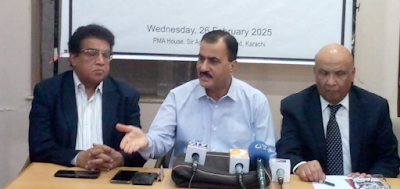Karachi resolves new response against polio cases
KARACHI: The metropolitan city of Karachi, with official scientific reports confirming significant prevalence of polio virus in its environment, is all set to witness administration of fractional dose intradermal inactivated polio vaccine (fIPV) into its deserving children from August 15 to 25 to protect them from infectious crippling disease which has affected 13 children countrywide, including one in Karachi so far this year.
A source in the health department
said that in view of month-wise data suggesting increase in detection of polio
(poliomyelitis) virus in various sewage samples, the authorities have resolved
to ensure new response activities, including administration of emergency fIPV
injection in high-risk areas, besides improving routine immunisation scheme of
the government for children, to boost the immunity in children of Karachi and
Sindh against polio and other vaccine preventable diseases.
As per official data, Sindh has 28
sites for environmental sample collection in its 15 districts, from where 111
samples tested positive for poliovirus so far in 2024. Positive samples were
received from all districts of Karachi (72), Hyderabad (14), Sukkur (8),
Jacobabad (5), Jamshoro (5), Mirpurkhas (3), Kambar (2), Badin (1) and Dadu
(1).
In the realm of polio, a
sewage water sample from an area is the basic parameter to determine
if polio vaccination campaigns are being carried out successfully, say
experts.
Sharing details of some recent
positive sewage water sample tests with this scribe, a senior communication
official at the Sindh Emergency Operation Centre (EOC) for polio said a sample
was collected from Chakor Nala site in Karachi East on July 18, which was the
24th positive sample from the district this year. The isolated virus has
been described “genetically linked to two viruses – one detected in an
environmental sample in Pishin (April 22 this year) and another detected in an
environmental sample in Hyderabad (June 3).
Lately, one positive sample was
collected from Korangi Nala site on July 18, which was seventh case from the district.
The isolated virus is genetically linked to the virus detected in an
environmental sample in the same district on June 13, the EOC official said.
In the meantime, Commissioner
Karachi Syed Hassan Naqvi chaired a review meeting on arrangements for launching
the proposed campaign in Karachi at Sindh EOC headquarters. He was told that a
special anti-polio campaign was being launched in Karachi’s high-risk areas in
collaboration with Sindh EPI, WHO and Unicef and other partners, with a resolve
to reach children and persuade parents to participate in it.
The required IPV vaccines for the
campaign have been provided by the Sindh EPI, said a source in EOC.
In all, 85 union councils in
Karachi, witnessing increase of polio virus, have been listed for the fIPV
campaign wherein about 4,700 teams comprising 4-5 members each, including
social mobilisers and inoculators and supervisors, will work within a defined
jurisdiction, with various outreach centres for 10 days.
As per the campaign plan, there are
47 union councils (UCs) which will be covered fully to reach all the children
of 4 months to 59 months of age for administration of fRIV, while the rest of
the earmarked UCs will be covered partially.
Maximum of 18 UCs have been selected
from district West to target 299,770 children for OPV and 273,695 children for
fIPV. Of the total, 14 UCs will be fully covered in the district.
Campaign managers have planned to
target 1,036,930 children for fIPV and 1,107,415 for OPV during the two-phase
campaigns, it is learnt.
A source privy to the polio
eradication activities in Sindh said a child is supposed to get 3 OPV doses and
two IPV doses, under the Expanded Programme on Immunisation (EPI), which are
considered sufficient to ensure immunity against polio virus in children.
When contacted, Sindh EPI Project
Director Dr Mohammad Naeem said that OPV administration rate among children was
up to the mark, but the coverage rates of IPV (two doses with a gap), included
in the routine preventive vaccination schedule, has been fluctuating for
reasons, which are now being focused for redressal.
In 2023, the rate of IPV-1 coverage
remained 89%, while the IPV-2 coverage rate came as 56.2%, he said, adding that
the rate of the IPV second dose administration can be questioned as parents
skipped that for their personal inconvenience.
Keeping in view hesitancy among
parents or caregivers of children in the administration of multiple injections
alongside IPV2 injection, authorities are considering replacement of
pentavalent vaccine and IPV with hexavalent vaccine to save the children from
the fear and pain of multi-inoculations at one time.
Moreover, the Sindh health minister and health secretary have already allocated budgets for provision of Panadol drops vials to the children who experience fever or pain due to administration of IPV-1 and IPV-2 jabs, he shared, adding the delivery of Panadol to deserving children will begin sometime in September this year. --MA





Comments
Post a Comment